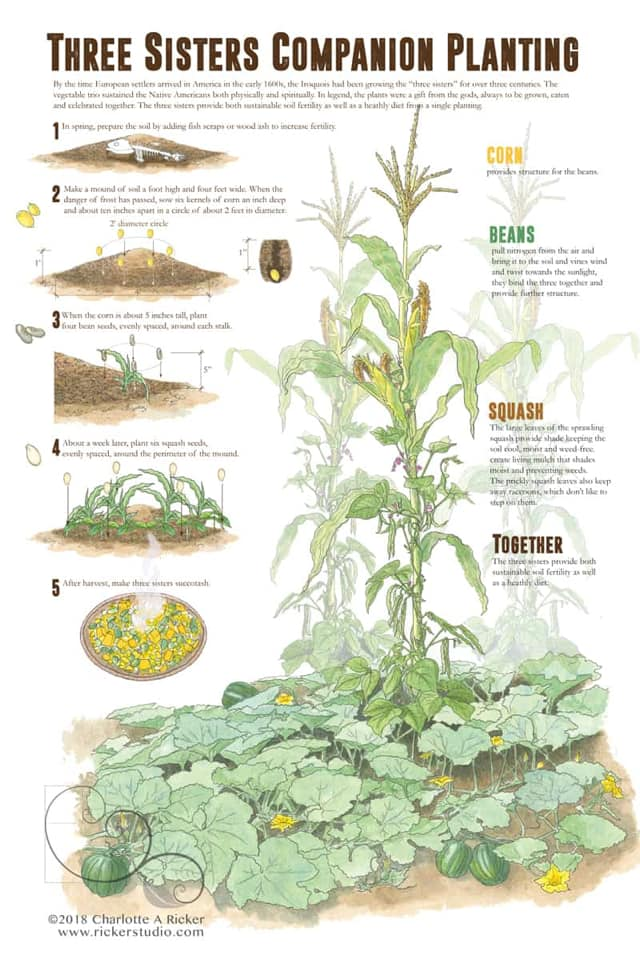What is the Three Sisters Planting?
When European settlers arrived in America in the early 1600s, the Iroquois had been growing the “three sisters” for over three centuries. The Pueblo and other tribes of the mid and south-western United States had been growing, especially corn, for centuries before that. The type of corn grown was a variety of “dent” corn, to which there are numerous varieties. This history of the corn has been well documented with seed being traded among the Native Americans throughout both north and south Americas. Dent corn is grown specifically to be dried and then ground into flour, which was their main food source.
The history of the Three Sisters companion planting however truly lies with the Iroquois peoples. This vegetable trio sustained their lives both physically and spiritually and continues to do so. In legend, the plants were a gift from the gods, always to be grown together, eaten together, and celebrated together. Ceremonies are done when the seeds are planted, again when the food is harvested and again whenever the food is consumed to give thanks to the ‘Creator’.
 Each of the sisters contributes something to the planting. Together, the sisters provide a balanced diet from a single planting.
Each of the sisters contributes something to the planting. Together, the sisters provide a balanced diet from a single planting.
- As older sisters often do, the corn offers the beans necessary support.
- The pole beans, the giving sister, pull nitrogen from the air and bring it to the soil to benefit all three.
- As the beans grow through the tangle of squash vines and wind their way up the cornstalks into the sunlight, they hold the sisters close together.
- The large leaves of the sprawling squash protect the threesome by creating living mulch that shades the soil, keeping it cool and moist and preventing weeds.
- The prickly squash leaves also keep away raccoons and other pests, which don’t like to step on them.
- Together, the Three Sisters provide both sustainable soil fertility and a healthy diet. Perfection!
Watch this video on the history of the Three Sisters planting through the eyes of the Iroquois culture.
How to Plant the Three Sisters
There are variations to the Three Sisters method, but the idea is to plant the sisters in clusters on low, wide mounds rather than in a traditional single row.
Before planting, choose a sunny location (at least 6 hours of full sun every day). This method of planting isn’t based on rows, so think in terms of a small field. Each hill will be about 4 feet wide and 4 feet apart, with 4 to 6 corn plants per hill. Calculate your space with this in mind.
- In the spring, prepare the soil with plenty of organic matter and quality compost. The Three Sisters love fish. Traditional a fish or fish scraps were placed in the mounds before planting. Wood ash can also be added if needed using sparingly so as not to burn the seeds.
- Make a mound of soil that is about a foot high at the center and 3 to 4 feet wide. The center of the mound should be flat and about 10 inches in diameter. For multiple mounds, space about four feet apart. Plantings have also been successfully done in rows, but again need to be mounded up and spaced 3 to 4 feet apart.
- Plant the corn first. Wait until the danger of frost has passed and night-time temperatures have reached 13°C (55°F). Check your local weather for frost dates. In most areas, planting should be done before June 1st, since corn requires a long growing season. Sow six kernels of corn an inch deep in the flat part of the mound, about ten inches apart in a circle of about 2 feet in diameter.
- Wait until the corn is about 6 inches to 1 foot tall before planting your beans. This ensures that the corn stalks will be strong enough to support the beans. The role of the beans is to fix nitrogen into the soil. Nitrogen is needed for strong corn stalk production.
Several varieties of pole beans can be grown within your mounds without worrying about hybrids, but just plant one variety per hill. Plant four bean seeds, evenly spaced, around each corn stalk.
- About a week to two weeks later, plant six squash seeds, evenly spaced, around the perimeter of the mound. There will be different recommendations for spacing depending on the variety of squash you are growing. Refer to the spacing recommendations on your seed packet. If you have saved seeds from a previous year, you can usually be safe with planting seeds about 18 inches apart. You may wish to put two seeds in each hole to make sure that at least one germinates.
- Sometimes, a fourth sister is included, such as a sunflower, which attracts pollinators and lures birds away from the seeds. Sunflowers can be planted at the cross-section of the spaces between the corn hills and harvested for seeds.
- As your Three Sisters planting grows you will need to weed and thin plants. Remove unwanted grass and weeds. Remove unhealthy plants. This will ensure that the healthiest and strongest plants will produce fruit.
Source: The Old Farmers Almanac



